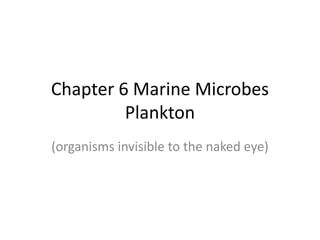
Chapter 6 marine microbes
- 1. Chapter 6 Marine Microbes Plankton (organisms invisible to the naked eye)
- 2. • Include viruses, one-celled organisms, and fungi. • Microbes play many different roles in marine ecosystem. • Phytoplankton-planktonic algae • Zooplankton-larvae of small animals-ex fish, jellyfish • We will discuss 3 of these in detail that you will be accountable for and be able to identify under a microscope 1. Diatoms 2. Dinoflagellates 3. Forams 4. Euglena 5. Volvox
- 3. Diatoms Characteristics • Most distinctive of plankton samples – Most common • Low latitudes-occur in coastal waters • Phytoplankton-Contributed to most of primary productivity of an area.
- 4. Diatom Structure • Bilaterally symmetrical • Glassy Cell wall • 2 valves- 1 large, 1 small • Visible geometrically shaped pattern-(helps distinguish between species)
- 5. Reproduction • Reproduction: • Digestion: – Asexually by – Makes own food fission (autotroph) via photosynthesis • When cells divides, each daughter gets one of the 2 valves • Eventually daughter that inherited smaller valve will reproduces sexually
- 7. • Level of organization: – Unicellular and eukaryotic • Ecological Role – Responsible for ~50% of oceans energy production – Producers
- 8. Dinoflagellates- structure • Globular, single-celled organisms • 2 flagella that lie in groves on the center of surface • Larger of phytoplankton
- 9. Reproduction • Asexually by fission – Split cell into two – Can happen at a rate of one division per day • Sexual in some species by gametes • If you had two species of Dinoflagellates and species A produced asexually while species B produced sexually, which species to you expect to survive throughout time longer and why?
- 10. • Ecological Role: Some species are responsible for Red Tide – algae bloom-large quick population boom – Produce toxins, usually cannot eat fish during this time – http://www.youtube.com/watch ?v=auEePWRqj7Y&safety_mode =true&persist_safety_mode=1& safe=active • Example (back side of Study Guide) Zooxanthellae are collections of dinoflagellates – They lack flagella like most species – Mutualistic relationships with corals, jellyfish, and mollusks.
- 11. Goodby’s Creek in Mandarin during last Algae Bloom
- 13. Forams Characteristics and Structure • Have a pseudopod-organelle that is an extension of the cell surface – Used for locomotion and food capture • Have a shell • deep as Marianas Trench • members of zooplankton
- 14. Foram Reproduction • Asexual fission most species • Sexual reproduction- some species
- 15. Forams: digestion/energy • Consume a lot of diatoms and dinoflagellates • Some host green/red algae – Symbiotic relationship • Forams get nutrients • Coral reefs get calcium carbonate
- 16. Ecological Role • Food for fish and invertebrates (inverts) • Turn over nutrients in the ocean • Most abundant group of fossils – Make up sediments
- 17. • http://www.youtube.com/watch?v=Fpry23bS 6g0&safety_mode=true&persist_safety_mode =1&safe=active
- 18. Ever wonder about that green gunk? • Its Euglena! – Possess chlorophyll, 1 or 2 flagella
- 19. Euglena • Salt or fresh water • Digestion- perform photosynthesis or absorb nutrients – stigma at base of flagella allows euglena to orient themselves towards a light source • Reproduce using binary fission – Split into two new organisms
- 20. Euglena Structure (draw sketch on back side of Study Guide)
- 21. Euglena: Ecological Role • Photosynthesizer • Acts as food for other protists and fish
- 22. • http://www.youtube.com/watch?v=4MlR3dKf Xmc&feature=related&safety_mode=true&per sist_safety_mode=1&safe=active •
- 23. Volvox • Structure: – Individual cells form colonies (level of organization= multicellular) up to 50,000 cells!!!!- cannot live alone – Eyespots that allow them to swim near light – Flagellates –locomotion • Similar to Euglena
- 24. Volvox Reproduction Asexual Sexual • Gonadia near the posterior – Divide numerous times to • Male colonies release produce new colonies sperm into water column – Genetically identical to the • Female colonies’ individual parent cells enlarge to become – Mitosis eggs • Offspring different from parents – Meiosis
- 25. Volvox Digestion • Producer • Makes energy via photosynthesis
- 26. Volvox Ecological Role • Primary producers in freshwater ecosystems – Lakes, ponds, ditches • Model science organism for cell death and regrowth • Some parasites feed off Volvox
- 27. Volvox • http://www.youtube.com/watch?v=He9FSeGR i3A&safety_mode=true&persist_safety_mode =1&safe=active
- 28. Independent Work Time • Finish back side of your study guide and turn in. – Study Guides will count as a homework/classwork assignment for Session 3 • You can find more information in Chapter 6 (blue MARINE BIOLOGY class set books)
Hinweis der Redaktion
- Left is how appear, right is how their probably appear through our microscopes